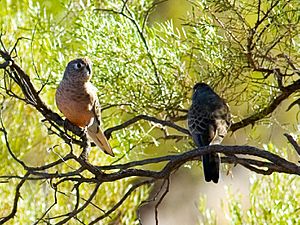Granite Downs facts for kids
Granite Downs was once a very large cattle station in the dry northern part of South Australia. A cattle station is like a huge ranch where cattle are raised. Today, this area is part of the Anangu Pitjantjatjara Yankunytjatjara lands, which are owned and managed by the Anangu Aboriginal people.
Discovering Granite Downs
Granite Downs covered a massive area of about 9,000 square kilometers (about 3,475 square miles). This makes it one of the biggest properties in the region. It was used for many years to raise cattle in the Australian outback.
A Special Place for Wildlife
Even though it was a cattle station, a significant part of Granite Downs is now recognized as very important for nature. About 552 square kilometers (213 square miles) of this land has been named an Important Bird Area (IBA). An IBA is a place that is vital for bird conservation around the world.
Birds of Granite Downs
This special area is home to many different kinds of birds. One important bird found here is the chestnut-breasted whiteface. This bird is considered "near threatened," which means its numbers are decreasing, and it needs protection. Granite Downs is especially important because it's one of the most northern places where this bird lives.
Other amazing birds that live in this area include:
- The inland dotterel
- The colorful Bourke's parrot
- The banded whiteface
- The black honeyeater
- The pied honeyeater
- The cinnamon quail-thrush
- The chiming wedgebill
- And the thick-billed grasswren
These birds rely on the unique environment of Granite Downs to survive and thrive. Protecting this area helps keep these wonderful species safe for the future.


